Podcast: Play in new window | Download
Subscribe: Apple Podcasts | RSS
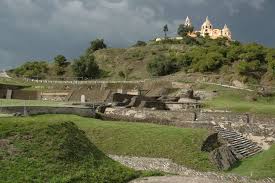 As the bells to the church dedicated to the Virgin of the Remedies rang, a young Swiss-American stood at the base of the broad hill on which the church sat. Old women wearing mantillas made of cactus fibers ascended the hill along with well-dressed men and children anxious to receive the word of God. The year was 1881. The Swiss explorer’s name was Adolph Bandelier and his many years roaming the American Southwest, Mexico and South America had made his eyes keen to spotting artificial formations out of natural ones. The massive hill which had been the home to La Virgen de los Remedios for nearly 300 years was really not a hill at all. Centuries of overgrowth combined with centuries of cultural memory loss had preserved a massive structure undisturbed at the time of Bandelier’s arrival. Little did he know when the first shovel hit the dirt in this rural part of the state of Puebla that he was excavating the largest pyramid ever built by man.
As the bells to the church dedicated to the Virgin of the Remedies rang, a young Swiss-American stood at the base of the broad hill on which the church sat. Old women wearing mantillas made of cactus fibers ascended the hill along with well-dressed men and children anxious to receive the word of God. The year was 1881. The Swiss explorer’s name was Adolph Bandelier and his many years roaming the American Southwest, Mexico and South America had made his eyes keen to spotting artificial formations out of natural ones. The massive hill which had been the home to La Virgen de los Remedios for nearly 300 years was really not a hill at all. Centuries of overgrowth combined with centuries of cultural memory loss had preserved a massive structure undisturbed at the time of Bandelier’s arrival. Little did he know when the first shovel hit the dirt in this rural part of the state of Puebla that he was excavating the largest pyramid ever built by man.
Although not as tall as the Great Pyramid at Giza, the Great Pyramid of Cholula is larger by volume and area, thus making it the largest known pyramid ever built and one of the largest buildings in the entire world. While the Great Pyramid in Egypt rises to a height of 455 feet, this Mexican pyramid rises to only 217 feet. However, Cholula’s volume is 4.45 million cubic meters versus Egypt’s 2.5 million cubic meters.
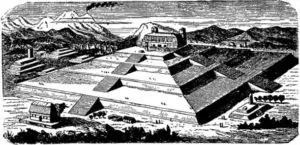 Since Bandelier’s time there have been two periods of intense excavations at the pyramid and much has been learned about the site from old Spanish documents, non-local native sources and the archaeological record. The name Cholula comes from the Aztec name Acholollan which derives from the Nahuatl word, cholollan, meaning, “place of refuge.” The site on which the Great Pyramid stands was first inhabited long before the formation of the Aztec Empire. Built in 4 stages across almost eight hundred years, the first human occupation at the site dates to the Preclassic Period at around 300 BC. The ceremonial site, according to legend, was built by a giant named Xelhua who escaped the Valley of Mexico after a flood. There is a central Mexican connection as there is a definite influence from Teotihuacan, the gigantic city that stood on the shores of Lake Texcoco near modern-day Mexico City and was contemporaneous with Cholula. Archaeologists often call Cholula and Teotihuacan “sister cities” although we do not know the relationship they had with each other 2,000 years ago at the height of both sites. At this time there was also great influence coming from the Gulf Coast of Mexico with ceramic types uncovered at Cholula closely resembling those of El Tajín in Veracruz. Through this ceramic
Since Bandelier’s time there have been two periods of intense excavations at the pyramid and much has been learned about the site from old Spanish documents, non-local native sources and the archaeological record. The name Cholula comes from the Aztec name Acholollan which derives from the Nahuatl word, cholollan, meaning, “place of refuge.” The site on which the Great Pyramid stands was first inhabited long before the formation of the Aztec Empire. Built in 4 stages across almost eight hundred years, the first human occupation at the site dates to the Preclassic Period at around 300 BC. The ceremonial site, according to legend, was built by a giant named Xelhua who escaped the Valley of Mexico after a flood. There is a central Mexican connection as there is a definite influence from Teotihuacan, the gigantic city that stood on the shores of Lake Texcoco near modern-day Mexico City and was contemporaneous with Cholula. Archaeologists often call Cholula and Teotihuacan “sister cities” although we do not know the relationship they had with each other 2,000 years ago at the height of both sites. At this time there was also great influence coming from the Gulf Coast of Mexico with ceramic types uncovered at Cholula closely resembling those of El Tajín in Veracruz. Through this ceramic 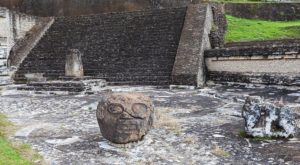 classification most archaeologists agree that the original inhabitants of Cholula were the Olmeca-Xicalanca with origins to the immediate east. According to the Toltec-Chichimec History, a codex from the Cholula area, a king with the name Aquiyach Amapane lived at the Great Pyramid. The city surrounding the pyramid complex was once the second largest in all of Mexico at its height with an estimated 100,000 people living there. By the 8th Century, the population of Cholula dropped off and no one knows why. The Great Pyramid was abandoned at that time, although it still retained its religious importance. In the Twelfth Century the area was conquered by the Toltecs who let the remaining Olmeca-Xicalancas stay, but only on the southern fringes of the city. The Great Pyramid was still important, but the main religious focus shifted to a new temple that the Toltecs built at the site near the pyramid. Later Toltec burials were found around the base of the pyramid, showing that the structure was still revered, although the Toltecs did not clear the pyramid of growth nor did they build on it. In fact, they named the pyramid Tlachihualtepetl which means “artificial hill.” Under the rule of the Toltecs, the ancient city of Cholula flourished and the population increased. In the 13th Century, feeling the pressure from the ever-expanding Aztec Empire, the Toltecs yielded to their overlords and Cholula became a client state of the Aztecs. By the time the Aztecs arrived, the Great Pyramid was so covered in vegetation that they did not use it nor did they try to clear it. Knowing that the hill was sacred to the natives, the Spanish constructed a church on top of it and dedicated the area to Our Lady of the Remedies, supplanting the shrine to the local Aztec rain goddess named Chiconauhquiahuitl whose feast day was September 8th. The Spanish made the feast day to Our Lady of the Remedies the same day, to ease the local population into Catholicism and so as not to create too much religious upset. In the 1960s, with the rise of a new indigenous consciousness in Mexico, the former Great Pyramid of Cholula became a place for a revived spring equinox celebration, which is closer in line with the original function of the pyramid, which, for most of its life was dedicated to the Mesoamerican god Quetzalcoatl. The equinox celebration is replete with Aztec dancers, poetry, fireworks, and the usual Mexican carnival fare, with the paleta man there alongside many other vendors.
classification most archaeologists agree that the original inhabitants of Cholula were the Olmeca-Xicalanca with origins to the immediate east. According to the Toltec-Chichimec History, a codex from the Cholula area, a king with the name Aquiyach Amapane lived at the Great Pyramid. The city surrounding the pyramid complex was once the second largest in all of Mexico at its height with an estimated 100,000 people living there. By the 8th Century, the population of Cholula dropped off and no one knows why. The Great Pyramid was abandoned at that time, although it still retained its religious importance. In the Twelfth Century the area was conquered by the Toltecs who let the remaining Olmeca-Xicalancas stay, but only on the southern fringes of the city. The Great Pyramid was still important, but the main religious focus shifted to a new temple that the Toltecs built at the site near the pyramid. Later Toltec burials were found around the base of the pyramid, showing that the structure was still revered, although the Toltecs did not clear the pyramid of growth nor did they build on it. In fact, they named the pyramid Tlachihualtepetl which means “artificial hill.” Under the rule of the Toltecs, the ancient city of Cholula flourished and the population increased. In the 13th Century, feeling the pressure from the ever-expanding Aztec Empire, the Toltecs yielded to their overlords and Cholula became a client state of the Aztecs. By the time the Aztecs arrived, the Great Pyramid was so covered in vegetation that they did not use it nor did they try to clear it. Knowing that the hill was sacred to the natives, the Spanish constructed a church on top of it and dedicated the area to Our Lady of the Remedies, supplanting the shrine to the local Aztec rain goddess named Chiconauhquiahuitl whose feast day was September 8th. The Spanish made the feast day to Our Lady of the Remedies the same day, to ease the local population into Catholicism and so as not to create too much religious upset. In the 1960s, with the rise of a new indigenous consciousness in Mexico, the former Great Pyramid of Cholula became a place for a revived spring equinox celebration, which is closer in line with the original function of the pyramid, which, for most of its life was dedicated to the Mesoamerican god Quetzalcoatl. The equinox celebration is replete with Aztec dancers, poetry, fireworks, and the usual Mexican carnival fare, with the paleta man there alongside many other vendors.
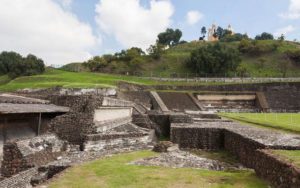 Besides early incursions to the Great Pyramid made by the Swiss-American Bandelier, Cholula is one of the only major archaeological sites excavated and studied completely by the Mexicans themselves. There were no Yale University or BYU expeditions to this site. The study of the pyramid, which remains mostly covered to this day, came in two phases: one from 1931 to the early 1950s, and the second one from 1966 to 1970. Buildings around the Great Pyramid have been cleared and studied throughout the 20th Century and into the 21st, but all explorations of the pyramid itself ceased over 50 years ago. Under the direction of Mexican architect Ignacio Marquina, tunnels were constructed into the body of the pyramid which uncovered the successive layers that were applied to the original structure over the course of the monument’s history. Marquina was hired by the Mexican government because of his restorative work in the 1920s at Teotihuacan. However, after his appointment to Cholula, he almost never made it down to Puebla from Mexico City. Great credit goes to the archaeological site’s caretaker, a local indigenous man named Mariano Gómez, who planned and oversaw the digging of the tunnels. An archaeologist on site, Eduardo Noguera, gathered ceramic materials from the tunnels and began constructing a timeline for the pyramid. They named the first pyramid Buliding A or “La Conejera”. It was built in about 300 BC, mostly out of simple adobe bricks built around a mound of earth with a stone core. The original building was painted black with white squares outlining the bricks. The second layer from the bottom, made sometime between 200 and 350 AD was called Building B or “The Pyramid of the Painted Skulls”. This pyramid was also made mostly of adobe, with rock mixed in, and the surface was smoothed out with earth and lime. It is during this phase when the ceramics match most closely with those of Teotihuacan to the north. The smoothed surface of the pyramid during this phase allowed it to be painted. Once can only imagine the 4 faces of this
Besides early incursions to the Great Pyramid made by the Swiss-American Bandelier, Cholula is one of the only major archaeological sites excavated and studied completely by the Mexicans themselves. There were no Yale University or BYU expeditions to this site. The study of the pyramid, which remains mostly covered to this day, came in two phases: one from 1931 to the early 1950s, and the second one from 1966 to 1970. Buildings around the Great Pyramid have been cleared and studied throughout the 20th Century and into the 21st, but all explorations of the pyramid itself ceased over 50 years ago. Under the direction of Mexican architect Ignacio Marquina, tunnels were constructed into the body of the pyramid which uncovered the successive layers that were applied to the original structure over the course of the monument’s history. Marquina was hired by the Mexican government because of his restorative work in the 1920s at Teotihuacan. However, after his appointment to Cholula, he almost never made it down to Puebla from Mexico City. Great credit goes to the archaeological site’s caretaker, a local indigenous man named Mariano Gómez, who planned and oversaw the digging of the tunnels. An archaeologist on site, Eduardo Noguera, gathered ceramic materials from the tunnels and began constructing a timeline for the pyramid. They named the first pyramid Buliding A or “La Conejera”. It was built in about 300 BC, mostly out of simple adobe bricks built around a mound of earth with a stone core. The original building was painted black with white squares outlining the bricks. The second layer from the bottom, made sometime between 200 and 350 AD was called Building B or “The Pyramid of the Painted Skulls”. This pyramid was also made mostly of adobe, with rock mixed in, and the surface was smoothed out with earth and lime. It is during this phase when the ceramics match most closely with those of Teotihuacan to the north. The smoothed surface of the pyramid during this phase allowed it to be painted. Once can only imagine the 4 faces of this 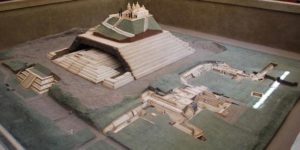 pyramid covered with murals during the height of the city’s power and prestige. After 350 AD, the pyramid was given another makeover and more layers were added to build up the structure. This building period lasted about a hundred years. This phase is labeled by archaeologists as Building C or “The Pyramid of the Nine Stories.” The Cholulans also used adobe bricks for this phase, but finished off the pyramid’s faces in rocks and stucco. The painting on the sides of the pyramid was less elaborate than that of the previous phase. This time, red, black and ochre paint was applied to the stucco, with red line patterns and some depictions of jaguars, serpents and other mythical creatures from the Mesoamerican cosmology.
pyramid covered with murals during the height of the city’s power and prestige. After 350 AD, the pyramid was given another makeover and more layers were added to build up the structure. This building period lasted about a hundred years. This phase is labeled by archaeologists as Building C or “The Pyramid of the Nine Stories.” The Cholulans also used adobe bricks for this phase, but finished off the pyramid’s faces in rocks and stucco. The painting on the sides of the pyramid was less elaborate than that of the previous phase. This time, red, black and ochre paint was applied to the stucco, with red line patterns and some depictions of jaguars, serpents and other mythical creatures from the Mesoamerican cosmology.
Surrounding the Great Pyramid, there are many things of archaeological importance that continue to be excavated and studied. On the south side of the pyramid is a complex of buildings called The Courtyard of the Altars. Curiously, in one of the four rooms of one of the larger buildings there exists a representation of the Great Pyramid in miniature, much like one would find in a museum. The whole complex bears a close architectural resemblance to Teotihuacan with its talud-tablero building form and types of materials used. The massive altars in the courtyard have low-relief carvings on them. Other stone sculptures were found in the vicinity, notably, a gigantic human head, which may be a cultural relic from Olmec times, when that civilization carved massive human heads out of stone.
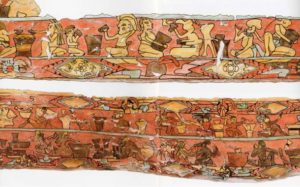 One of the most curious finds at Cholula to date is what has been called the largest mural in all of Mexico and is named “The Mural of the Drinkers.” It was discovered accidentally in 1969 when an archaeologist named Ponciano Salazar Ortegón was digging and part of a building collapsed. The mural was discovered 25 feet below the surface and dates to about 200 AD. The mural’s subject is an elaborate banquet, with the people depicted therein engaging in what some have called the first depiction of ritual pulque drinking. The mural measures 187 feet long and is masterfully done with hundreds of revelers engaged in a variety of activities, illustrated in lively colors. There are other smaller murals throughout the site, but there is a lot yet to be uncovered at Cholula.
One of the most curious finds at Cholula to date is what has been called the largest mural in all of Mexico and is named “The Mural of the Drinkers.” It was discovered accidentally in 1969 when an archaeologist named Ponciano Salazar Ortegón was digging and part of a building collapsed. The mural was discovered 25 feet below the surface and dates to about 200 AD. The mural’s subject is an elaborate banquet, with the people depicted therein engaging in what some have called the first depiction of ritual pulque drinking. The mural measures 187 feet long and is masterfully done with hundreds of revelers engaged in a variety of activities, illustrated in lively colors. There are other smaller murals throughout the site, but there is a lot yet to be uncovered at Cholula.
One does not have to go to Egypt to marvel at monumental architecture and amazing ancient public buildings. The largest pyramid in the world is right in our own backyard. Few people know of the Great Pyramid of Cholula, partly because it hasn’t been completely excavated like many of the other major archaeological sites in Mexico and it isn’t much of a tourist draw. The fact that the site has been under complete control of the Mexicans also has something to do with it. As stewards of their own cultural heritage, the Mexican archaeologists appreciate the need to keep the tourists away and to preserve the past for future Mexicans. For this reason, remember, if you ever decide to go to Cholula, please tread lightly.
REFERENCES: Online travel web sites only.

3 thoughts on “Cholula: The Largest Pyramid in the World”
Hello, Robert! I’m a Latin American historian in California and I’m giving a TEDx talk next week (3/28/17) at my university and wondered if I might have permission to reproduce your images of the pyramid model and of Los Bebedores/The Drinkers on my power point slides accompanying the talk. If so, let me know how/if you would like me to cite them. Here’s more information about me: http://www.tedxazusapacificuniversity.com/speakers/v-gutierrez/ I appreciate your time. Best, Veronica
Dr. Gutiérrez, I am honored that you would consider using elements of my show in your presentation. A reference to my website here would be much appreciated. Best of luck next week at your TED talk and please let me know if I can help in any other way. —Robert
Thank you, Robert! I really appreciate your prompt response. I will certainly reference your website. Best, Veronica